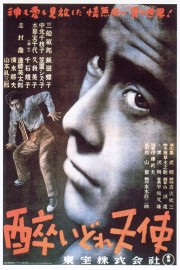Drunken Angel
Akira Kurosawa is the first name I would suggest to anyone looking to dive into world cinema, and it’s because of the relationship he has with genre. For much of his career, he was looked at as “too Western,” and that’s because of the way he embraced American cinematic genres and tropes to reflect something he wanted to say in his own work. The most obvious examples are his samurai films, inspired by the pictures painted by John Ford of the American old west, but he also did work in crime and film noir, as well; that is where “Drunken Angel” comes into play.
The screenplay by Kurosawa and Keinosuke Uekusa centers around a town in post-war Japan. At the center of it is a pool of standing water, dirty and infected with disease; it doesn’t get too far into “Drunken Angel” when that becomes a symbol for much of what we witness happening in the film. The film begins with Matsunaga (Toshirô Mifune), a low-rent criminal in town, stumbling into the office of a doctor, Sanada (Takashi Shimura), one night. He is drunk, and sick; it could be tuberculosis, something Sanada is a bit of an expert in. The two get into a scuffle, but Sanada asks him to get an x-ray so that he can confirm his thoughts, and the two form a bond. In a way, they are not far removed from one another- Matsunaga and Sanada are both drinkers, and people whose pasts have kept them from going further in their lives. When a local crime boss gets out of prison, their tenuous friendship, as well as the women Sanada have in his life (including one that used to be involved with the crime boss), will be tested.
The film’s title seems to refer to Sanada more than it does Matsunaga, as it’s Sanada who takes Matsunaga under his wing, to a certain respect, and tries to help him more than he probably deserves, but, by the end, it can refer to Matsunaga, as well, as he begins to make selfless choices for the purposes of those whom have taken him in, even if he will fail, to an extent. In a way, the aspect of the film with the crime boss seems to bog the film down in plot, when the most interesting aspects of the film are the by-play between Mifune and Shimura, and the way these characters have a co-dependency that starts out toxic, but is a genuine friendship by the end. Throughout the film, Sanada has a female patient that comes in, and we see the progress she makes in curing her TB; it’s the contradiction of the doctor’s life that their use is helping people defeat the thing that brought them to the doctor in the first place, only to have them leave when they are healthy. Matsunaga is the worst type of patient, but he also shows himself to be a genuine man, and that’s something Sanada doesn’t expect the first time Matsunaga barges into his door. When they are on screen together, Mifune and Shimura are wonderful, and it’s easy to see why Kurosawa collaborated with them, time and again, in the decades to come.










